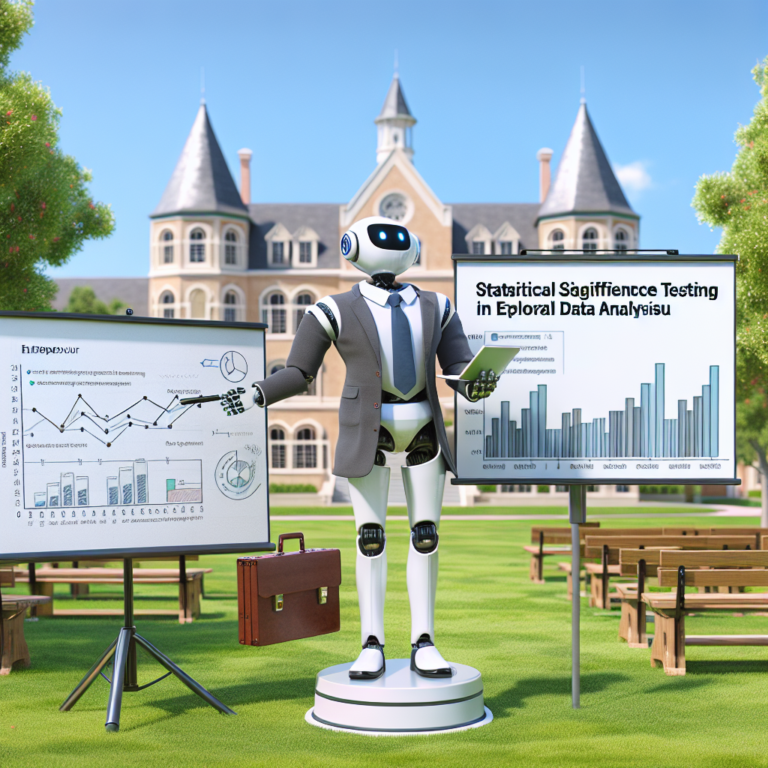1. Understanding Non-Normal Datasets
When analyzing data, it’s crucial to recognize when a dataset deviates from normal distribution. Non-normal datasets are common in real-world data and require specific analytical approaches. This section explores what non-normal datasets are, why they matter, and how they can significantly impact statistical analysis.
Characteristics of Non-Normal Datasets
- Skewness: Data that are skewed have a distribution with an asymmetric tail. For instance, income data often are right-skewed, meaning most people earn below the average, but a few high incomes pull the average up.
- Kurtosis: This refers to the ‘tailedness’ of the data distribution. High kurtosis means more of the variance is due to infrequent extreme deviations, as opposed to frequent modestly sized deviations.
Implications of Non-Normality
- Statistical tests that assume normality, such as the t-test or ANOVA, may not be valid for non-normal data, potentially leading to incorrect conclusions.
- Estimates of parameters like mean and variance may be misleading, affecting forecasts and decisions based on the data.
Understanding these characteristics helps in choosing the right non-parametric methods and EDA techniques to analyze such data effectively. Recognizing non-normality in datasets is a critical first step in applying appropriate statistical methods that yield valid and reliable results.
2. Overview of Non-Parametric Methods
Non-parametric methods are essential for analyzing data that does not assume a normal distribution. These methods are particularly useful when you cannot satisfy the assumptions required by parametric tests. This section delves into the core concepts and utilities of non-parametric methods in statistical analysis.
Core Concepts of Non-Parametric Methods
- Independence from distribution models: Non-parametric methods do not require the data to follow any specific underlying distribution.
- Flexibility: These methods are adaptable to various types of data, including ordinal or nominal data, where parametric tests fail.
Utility of Non-Parametric Methods
- Handling skewed data: They are ideal for data with outliers or skewed distributions, providing more accurate results where parametric tests might be misleading.
- Small sample sizes: Non-parametric methods can be applied effectively even with small data sets, unlike many parametric methods that require larger samples to ensure reliability.
By employing non-parametric methods, analysts can derive insights from non-normal datasets without the constraints of parametric assumptions. This adaptability makes non-parametric methods a valuable tool in the arsenal of modern data analysis, particularly when dealing with real-world data where normality cannot be assumed.
Understanding these methods enriches your analytical skills and broadens the scope of data you can handle effectively using EDA techniques. Whether you are dealing with highly skewed data or small samples, non-parametric methods provide the tools necessary to perform robust and reliable analysis.
2.1. Benefits of Using Non-Parametric Methods
Non-parametric methods offer distinct advantages in data analysis, especially when dealing with non-normal datasets. These methods are robust, versatile, and less reliant on assumptions, making them ideal for a wide range of data types.
Robustness Against Outliers
- One of the key strengths of non-parametric methods is their robustness to outliers. Unlike parametric tests, which can be heavily influenced by extreme values, non-parametric methods minimize the impact outliers have on the results.
Minimal Assumptions Required
- Non-parametric methods do not assume a specific distribution of the data. This is beneficial because it eliminates the need for normality tests and transformations, simplifying the analytical process.
Applicability to Different Data Levels
- These methods can be applied to data at various levels of measurement, including nominal, ordinal, interval, or ratio scales. This flexibility allows for broader application across different fields and research types.
Employing non-parametric methods enhances the validity of the analysis when the data does not conform to the typical assumptions required by more traditional statistical tests. This makes them particularly valuable in exploratory data analysis (EDA techniques) where the data’s distribution is unknown or in its preliminary stages of research.
Overall, the benefits of using non-parametric methods in data analysis include increased flexibility, fewer assumptions, and greater robustness, which are crucial when handling real-world data that often deviates from theoretical models.
2.2. Common Non-Parametric Tests and Their Applications
Non-parametric tests are crucial tools in statistical analysis, especially when dealing with non-normal datasets. This section highlights some of the most commonly used non-parametric tests and their practical applications across various fields.
Mann-Whitney U Test
- Used for comparing differences between two independent groups when the dependent variable is either ordinal or continuous but not normally distributed.
Kruskal-Wallis H Test
- An extension of the Mann-Whitney U Test, it compares more than two independent groups to determine if there is a statistically significant difference in their medians.
Wilcoxon Signed-Rank Test
- This test is used for comparing two related samples to determine whether their population mean ranks differ. It is the non-parametric alternative to the paired t-test.
Spearman’s Rank Correlation Coefficient
- Used to measure the strength and direction of association between two ranked variables. It is especially useful when the assumptions of Pearson’s correlation are not met.
These tests are particularly valuable in fields like environmental science, where data may not conform to normality due to factors like skewed resource distributions or in medical research where sample sizes are small and data distributions can be irregular.
By utilizing these non-parametric methods, researchers can perform robust and reliable analyses without the stringent assumptions required by parametric tests. This adaptability makes non-parametric tests essential for exploratory data analysis (EDA techniques), providing insights that are critical in the preliminary stages of research.
3. EDA Techniques for Non-Normal Data
Exploratory Data Analysis (EDA) is crucial for understanding non-normal datasets. This section highlights key EDA techniques that are effective in analyzing such data.
Key EDA Techniques:
- Histograms and Box Plots: These visual tools help identify the shape of the distribution, pinpointing skewness and outliers.
- Quantile-Quantile (Q-Q) Plots: Q-Q plots are used to visually assess if the data deviates from a normal distribution by comparing it against a theoretical normal distribution.
Applying EDA Techniques:
- Data Transformation: Sometimes, non-normal data can be transformed into a normal distribution through logarithmic or square root transformations, making it easier to apply traditional statistical methods.
- Non-Parametric Tests: For data that remains non-normal even after transformation, non-parametric methods like the Mann-Whitney U test or the Kruskal-Wallis test can be used.
Utilizing these EDA techniques allows analysts to make informed decisions about the appropriate statistical tests and methods to apply, ensuring that the analysis of non-normal datasets is both accurate and meaningful. By integrating non-parametric methods and EDA techniques, you can enhance your data analysis skills and better understand the underlying patterns and anomalies in your data.
3.1. Visualizing Non-Normal Data
Effective visualization is key to understanding non-normal datasets. This section covers essential techniques that help reveal the underlying structure of such data, enhancing your exploratory data analysis (EDA) capabilities.
Box Plots
- Box plots provide a visual summary of data distributions, highlighting medians, quartiles, and outliers. They are particularly useful for spotting skewness and potential anomalies in data.
Histograms
- Histograms help in understanding the distribution of data by displaying the frequency of data points within certain range bins. They are ideal for identifying the shape of the data distribution, such as bimodal or skewed patterns.
Scatter Plots
- Scatter plots are effective for visualizing the relationship between two variables. When dealing with non-normal data, they can help detect patterns, trends, and outliers that might not be apparent in other types of plots.
Q-Q Plots
- Quantile-Quantile (Q-Q) plots are crucial for comparing the distribution of a dataset against a known distribution, typically the normal distribution. They are instrumental in determining deviations from normality.
Utilizing these visualization techniques allows you to conduct a thorough EDA that accommodates the peculiarities of non-normal datasets. By visually assessing these datasets, you can better decide on the appropriate non-parametric methods to use for further analysis.
3.2. Descriptive Statistics Without Normal Assumption
Descriptive statistics form the foundation of data analysis, providing initial insights into the data’s structure. However, traditional methods often assume normality, which isn’t always applicable. This section highlights key techniques in descriptive statistics that do not rely on this assumption.
Median and Interquartile Range (IQR)
- The median offers a better measure of central tendency for skewed data than the mean, which can be misleading.
- IQR, which measures the middle 50% of data points, provides insights into data spread without assuming symmetry.
Mode
- The mode, or the most frequently occurring data point, is particularly useful in analyzing categorical data and is unaffected by extreme values.
Non-Parametric Variability Measures
- Measures such as the range and the median absolute deviation (MAD) describe variability without assuming a specific data distribution.
Employing these statistics allows analysts to gain accurate insights from non-normal datasets, crucial for making informed decisions. These methods ensure that the analysis remains robust, even when the data does not conform to normal distribution assumptions, making them indispensable in the toolkit of modern data scientists using EDA techniques and non-parametric methods.
Understanding and applying these techniques can significantly enhance the reliability of your data analysis, ensuring that your conclusions are based on the actual characteristics of the data rather than the assumptions imposed by traditional parametric methods.
4. Case Studies: Applying Non-Parametric Methods in Real-World Scenarios
Real-world applications of non-parametric methods demonstrate their versatility and effectiveness in various fields. This section highlights several case studies where these methods have been crucial in analyzing non-normal datasets.
Healthcare: Improving Diagnostic Accuracy
- In medical research, non-parametric tests have been used to analyze the effectiveness of new treatments where data distributions are unknown or skewed due to small sample sizes.
Finance: Risk Assessment Models
- Financial analysts often employ non-parametric methods to assess risk and return models, especially when dealing with non-normal distributions of returns, which is common in financial markets.
Environmental Science: Studying Climate Change Impacts
- Researchers in environmental science use these methods to analyze data on climate variables, which often do not follow a normal distribution, to better understand the impacts of climate change.
These case studies illustrate how non-parametric methods facilitate robust data analysis across different sectors. By applying these techniques, professionals can derive more accurate insights from complex datasets, enhancing decision-making processes. This adaptability is particularly valuable in fields where data anomalies are common, ensuring that analyses remain valid and reliable.
Each case study underscores the importance of EDA techniques in preparing data for analysis, ensuring that the insights gained are based on sound statistical reasoning. This approach not only broadens the scope of data analysis but also increases the reliability of the results obtained, making non-parametric methods indispensable in modern data analysis.
5. Tools and Software for Non-Parametric Data Analysis
Effective data analysis requires robust tools and software, especially when dealing with non-normal datasets. This section introduces some of the most widely used tools and software for non-parametric data analysis, highlighting their features and applications.
1. R and the ‘np’ Package
R is a powerful statistical programming language favored for its extensive package ecosystem. The ‘np’ package specializes in non-parametric methods, offering functions for kernel smoothing, regression, and density estimation. This makes it an invaluable tool for analysts who require flexibility beyond standard parametric approaches.
2. Python and SciPy
Python is renowned for its simplicity and versatility in data analysis. The SciPy library extends Python’s capabilities by providing a module for statistical functions, including several non-parametric tests such as the Mann-Whitney U test and the Kruskal-Wallis test. These functions are essential for analyzing samples from non-normal datasets.
3. SAS
SAS offers robust options for non-parametric analysis through procedures like NPAR1WAY and FREQ. These procedures handle tasks from hypothesis testing to analysis of variance without assuming a normal distribution, suitable for enterprise-level data analysis.
Utilizing these tools effectively allows data scientists to apply non-parametric methods and EDA techniques to extract meaningful insights from data that does not fit the normal distribution mold. Mastery of these tools enhances the analytical capabilities, enabling more accurate and insightful data interpretations.
Choosing the right tool depends on your specific data requirements and the complexity of the analysis needed. Each of these platforms offers unique strengths that can be leveraged to perform comprehensive non-parametric data analysis.
6. Challenges and Considerations in Non-Parametric Analysis
While non-parametric methods offer significant advantages for non-normal datasets, they also present unique challenges and considerations. This section outlines the key issues to be aware of when employing these methods in data analysis.
1. Data Interpretation Challenges
Non-parametric methods often yield results that are less intuitive than their parametric counterparts. For instance, results from tests like the Mann-Whitney U test provide median comparisons rather than means, which can complicate the interpretation for those accustomed to parametric results.
2. Efficiency and Power
Non-parametric tests are generally less powerful than parametric tests, meaning they require larger sample sizes to achieve the same level of statistical significance. This can be a limitation in studies where data collection is costly or difficult.
3. Over-reliance on Assumptions
Although non-parametric methods do not assume a normal distribution, they are not completely assumption-free. They often require assumptions about the shape of the distribution, such as symmetry, which if violated, can lead to inaccurate conclusions.
Understanding these challenges is crucial for effectively applying non-parametric methods and EDA techniques. By acknowledging and addressing these considerations, analysts can better leverage the strengths of non-parametric analysis while mitigating its limitations.
Ultimately, the choice between parametric and non-parametric methods should be guided by the specific characteristics of the data and the objectives of the analysis. Awareness of these challenges ensures that the selected statistical methods align well with the underlying data properties and analysis goals.



